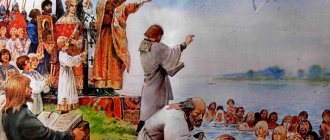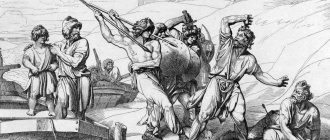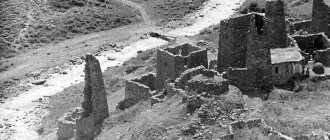Omitting the discussion of the plan of events aimed at 2022, once again I would like to ask two questions: 1. Why is the organization of such celebrations discussed without the participation of representatives of the south of Alanya? 2. Why is the date of the introduction of Christianity into the territory of Alanya so brazenly underestimated?
Our newspaper has been raising the issue of the illegality of our northern brothers’ artificially lowering this date for several years now, citing specific examples of the incompetence of their argumentation. Nevertheless, in the north they continue to insist on their own, and have already “reached” the point of actually misleading the head of the Russian state. Why they threw out at least 600 years from the history of their people is simply unclear.
Let me note right away that I am not an adherent of the Christian faith, since I am an adherent of national beliefs. But elementary objectivity, the truth of history, which is already distorted by us ourselves, makes us speak again, as if the Ingush, Georgians, and Karachais are not enough for us.
To the history of the issue. Armenia and Georgia date their Christianization to the 4th century - 301 and 326, respectively. Moreover, Christianity here was not accepted by the entire country, but at that time only by a couple of principalities. Why are we drawing your attention to this? In the north they are trying to explain their “theft” of history by the declared year 916, by the fact that Alania had only become completely Christianized by that time. But, firstly, Alanya has not yet been completely Christianized and the folk faith has been no less, if not more, strong throughout the existence of our ethnic group. Secondly, Christianization is considered throughout the world from its first sprouts in the country, as in the examples of the Transcaucasian states mentioned above. And, by the way, the adoption of Christianity by Russia itself (988) was also, to put it mildly, partial.
Well, let's try to reach you again. To begin with, an elementary question - if our neighbors Armenia and Georgia adopted Christianity at the beginning of the 4th century, what did Alania do for six whole centuries, how was it able to “fence itself off”, and why, in this case, did it enter into dynastic marriages with non-believers and provide them with military assistance? The guardians of the 1100th anniversary are unlikely to find intelligible answers to these seemingly ordinary questions. Therefore, we repeat again, there is no need to rush to conclusions and celebrations. History, for all its simplicity, is a complex science. Although many questions are often on the surface...
It is well known that our ancestors were among the first to hear, as they say, the good news. The teachings of Christ were brought to the land of Alanya in the 1st century by the apostles Andrew the First-Called and Simon the Canaanite (40 AD). Another apostle, Matthew, who preached in Western Asia, knowing about his approaching death, arrived in Alanya and was buried on its territory . Over the years, a diocese was formed in Lesser Scythia - Scythian or Tomitan, and in Tauro-Scythia five dioceses were known: Kherson, Gothic, Sros, Fula and Bosporus. The seat of the Scythian diocese was the famous trading city of Tolen. Before 451, that is, before the Council of Chalcedon, 12 Scythian (Alanian) bishops were already known, and they were independent in the management of their diocese. Needless to say, at the same time, dioceses are not created overnight... Moreover, after the Council of Chalcedon, we find mention of the Alan (As) Diocese itself. Here the ethnic component is identified with administrative-territorial boundaries. By the way, information about the Alan Diocese is also available in the monthly book of the Byzantine Emperor Vasily, indicating that the Alan diocese “... has had its own bishop for more than half a century, and, moreover, this is not the first bishop.”
If we return to the IV century we declared, associated with the adoption of Christianity by Armenia and Georgia, then the following should be noted. At this time, Saint Nina of Cappadocia begins to preach in neighboring Georgia. Moreover, Nina went with military escort to preach in the Georgian region of Pshav-Khevsureti...
The path passed through Alanya and among our ancestors Nina’s arrival did not cause any special favor or special protests. The Alans... were already familiar with the faith (!), “which was brought by the Greek Andrei”...
The fact that the “anniversary” date of the adoption of Christianity by Alania-Ossetia is unjustifiably underestimated is also believed in the Alan Diocese of South Ossetia. This is what five years ago, regarding the intention to celebrate in the north of Alanya the 1100th anniversary of the adoption of Christianity by Alanya, the Dean of the churches of the Alan Diocese of South-
Noah Ossetia, Father Jacob (Khetagurov):
– Intending to celebrate the 1100th anniversary of Alanya’s adoption of Christianity, we are seriously underestimating the real date. There is no need to rush with such anniversaries. Coverage of religion throughout the country? But in ancient times, such a concept as a state border was conditional. Especially if we talk about our ancestors, whose distribution area was enormous. In addition, in the same neighboring Georgia, which was fragmented and did not represent a single whole, the adoption of Christianity is counted from the baptism of St. Nina of the king of Iberia. But this does not mean that Georgia completely became Christian overnight. Only two principalities. Just as all of Rus' did not accept Christianity in 988, but only partially... Yes, the Alans erected temples that date back to the 10th century, but this indicates the flowering of Christianity, but not its origin. They couldn't appear overnight. Moreover, the architectural solutions of these temples indicate the presence of their own special style... By ignoring these facts, we, in my opinion, are actually committing a crime against the future generation.”
Let us once again draw attention to the fact that Armenians and Georgians, speaking about the date of adoption of Christianity by their country, understand that not all the people accepted this faith. Just like in Alanya, where the introduction of Christianity was progressive. But if in the north of Alanya they are trying to appeal to the year 916, when Christianity was supposedly “recognized” in the northern regions of the country, and previously it did not cover the entire territory of Alanya, then, in this case, it never covered it
, neither during Tsarist Russia, nor now. Although missionary work continues. It is no coincidence that our Constitution enshrines both the national faith and Christianity on an equal basis. We must follow the historical truth and not artificially underestimate, for the sake of unknown reasons, the facts of history. And reconsider the date of the 1100th anniversary...
Republic newspaper
L. Dzhioev
From the history of the birth of Christianity in Alanya
The teachings of Christ were brought to our land by the apostles Andrew the First-Called and Simon the Canaanite. Another apostle, Matthew, who preached in Persia and Media, knowing about his approaching death, arrived in Alanya and was buried on its territory.
Judging by the accumulated scientific data, with the appearance of the Scythians in the steppes of the Northern Black Sea region and the Caucasus in the 7th century BC. e. here began the long-term dominance of the tribes of the northern Iranian ethno-linguistic circle. The so-called “great belt of steppes”, stretching from Altai to the Danube, passed into the hands of the Scythians. The remnants of the Scythians and Sarmatians who survived the violent upheavals of the era of the “Great Migration of Peoples” were called “Alans” in written sources of the early Middle Ages. The main region inhabited by Alans since the first centuries of our era is the plains and foothills of the North Caucasus, mainly in its central part, between the upper reaches of the Kuban and Terek. This territory in Greek-Byzantine and other sources was called “Alania”, and here the modern Ossetian people were formed. Ancient Scythia consisted of two parts - Lesser Scythia and Tauro-Scythia. The first seeds of Christianity were brought here in the 1st century, in 40 AD. e., when the Apostle Andrew preached the Christian faith among the ancestors of the Ossetians. In Scythia Minor there was only one diocese - Scythian or Tomitan, and in Tauro-Scythia up to five dioceses are known: Kherson, Gothic, Sros, Fula and Bosporus. The seat of the Scythian diocese was the famous trading city of Tolen. Until 451, that is, before the Council of Chalcedon, the Scythian bishops (12 of them are known) were independent in the administration of their diocese. This Council subordinated the Scythian See to the Patriarch of Constantinople. Hence the explanation why Saint John Chrysostom, Archbishop of Constantinople, took an active part in enlightening the Scythians with the faith, sending shepherds and teachers to them.
One of the reliable facts of contact between the Alans and Christianity is contained in Armenian sources. This is “The Lives of the Holy Martyrs of Mesukeve.” The “Life” is based on a completely reliable historical fact, described by Moses of Khorensky: the Alan princess Satenik marries the Armenian king Artashes. Together with the princess, the Alan nobility, relatives of Satenik, also came from the country of Alans, who adopted Christian teaching from the holy men, disciples of the holy Apostle Thaddeus, who had retired to the sources of the Euphrates River. And the holy martyrs remained on Mount Sukavet (according to the commentary of R. A. Gabrielyan, now it is Mount Kosedag in the Alashkert valley) and began to be called Mesukevi.
Byzantine sources mention the Alanian king Gregory (VII century): “The ruler of Alania, Gregory, is God-fearing, Christ-loving and bears a Christian name, he was baptized.” To understand the state of Christianity in Alanya in the 7th century. this is quite significant. To perform the sacrament of baptism, completely objective and real conditions had to exist, such as a temple, a font, priests, and church equipment. This means that all this happened in Alanya in the 7th century. We can speak with confidence about the existence of the monastery of John the Baptist in Alanya in the second half of the 7th century, where the ruler of Alanya, Gregory, baptized his entourage. This was a serious stage in the Christianization of Alanya. Based on historical and archaeological materials, an idea has emerged of the 11th–12th centuries as the “golden age” in the history of Alanya. The Alans acquired political sovereignty, and their military power increased significantly. The internal readiness of the Alans to accept Christianity as the state religion was combined with a favorable political situation. Byzantium saw Alania as the only strong and reliable ally in the Caucasus.
In 916, the great baptism of Alania took place, and later, in 988, there was the baptism of Rus'. Mass baptism of Alans took place in the Nizhne-Arkhyz settlement (not far from the village of Zelenchukskaya, Karachay-Cherkessia). The sacrament was performed in three Alanian churches: the Northern Church (of the Holy Great Martyr and Victorious George); Middle Church (Holy Trinity); Southern Temple (Prophet Elijah). It should be noted that these three Alanian churches (IX–X), which have survived to this day, are the oldest Christian churches in Russia. In the Church of St. George the Victorious (Northern), the oldest font in Russia has also been preserved, where our Alan ancestors received holy baptism.
Also, the baptism of many Alans was performed in running water. This is the Big Zelenchuk River, flowing between the ancient Lower Arkhyz temples and the Alan rock image of Jesus Christ.
The great baptism of Alania played a positive role in the development and strengthening of Alanian statehood. Thus began the “golden age” of Alania, which lasted until the arrival of the Mongol-Tatar hordes of Timur and Genghis Khan, who exterminated our ancestors, destroyed temples and monasteries, mercilessly killed the Alan clergy and implanted an alien religion in Christian Alania with fire and sword.
The almost five-century existence of the Great Alan Metropolis suggests that Christianity had strong roots here. Torn away from their Christian shrines, the descendants of the Alans - the Ossetians, driven into the mountains, fleeing from wholesale extermination (the population of Alania decreased from several million to tens of thousands), moved the Christian shrines dear to them to the mountains of modern Ossetia.
The appearance in the Caucasus at the beginning of the 4th century of the relative of St. George the Victorious, Equal-to-the-Apostles Nina, the enlightener of the Caucasus, contributed to the strengthening of Christianity, especially in Georgia and Ossetia. After preaching the Christian faith in Georgia, Saint Nina from Mtskheta went to Ossetia, where she converted many to Christ. Saint Nina's preaching was accompanied by mass healing of the sick and suffering. In Ossetia they said about her: “This holy woman heals the sick and, at the same time, preaches the very faith that was preached by the apostles Andrew the Great and Simon the Zealot.” She built churches, bringing the light of Christianity to the peoples of Ossetia, Georgia and the entire Caucasus. Thanks to Saint Nina, our ancestors began to venerate the Great Martyr George and his suffering as a courageous and brave warrior of Christ. Despite the fact that the celebration of his wheeling (Dzheorguyba) has acquired many traditions and customs, the roots remain Orthodox.
The invasion of Timur's hordes devastated Ossetia. Internecine wars caused great harm to the integrity of Ossetia, dividing Ossetia into South and North. After this misfortune, Ossetia once again gained independence for some time and came to a flourishing state. At the end of the 12th century, in the Alagir Gorge, Os-Bagatar was born into an ancient Alan clan... Both Os-Bagatar himself and his brothers were raised in the Christian spirit. Seeing his compatriots in severe oppression from Timur, Os-Bagatar decided to free Ossetia from the heavy foreign yoke and unite the northern and southern Ossetians into one state.
Preaching the Gospel diligently, Os-Bagatar and his brothers Isaac, Roman and Vasily actually managed to unite the northern and southern Ossetians into one state and restore Christianity as the state religion of Ossetia.
First of all, they erected a monastery in the name of the Most Holy Trinity in the Tseyskoye Gorge, the ruins of which have survived to this day. Another monastery was built by them in the name of the archangels Michael and Gabriel in the Kasar Gorge. Throughout Ossetia, churches destroyed by hordes of Mongol-Tatars were restored and new ones were built, and the Ossetian clergy, with the power of the word of God, healed the moral wounds of Ossetia. In Ossetia itself, legends about those glorious times of native history were preserved not only in folk songs and legends, but also in the historical inscription on the wall of the Nuzal temple with the image of Ossetian kings. In the oldest Ossetian Orthodox Church of Ossetia, the Most Holy Trinity Rekom, there was the shield and sword of Os-Bagatar. An ancient letter from the Tsarazont family was also kept in the Nuzal chapel of the century. From generation to generation it was passed down as a shrine. In the middle of the 19th century, this unique document, the poem “Song of Alguz”, was taken from Nuzal by a Georgian priest to Georgia. From him it found its way into the press and into the collection of manuscripts of the Georgian Literacy Society (No. 541). The poem includes 1140 verses, set out in quatrains, a classic example of ancient poetry.
The holy and blessed Queen Tamara, who reigned in Georgia at the end of the 12th and beginning of the 13th centuries, made an invaluable contribution to the strengthening of Christianity in Ossetia. She combined with the wisdom of public administration a holy zeal for the spread and establishment of the Christian faith in Georgia and Ossetia. The remains of temples built by it in the mountains and gorges of Ossetia are still monuments of this antiquity. Tamara was the daughter of the Ossetian princess Burdukhan (daughter of the famous Ossetian king and military leader Khudan, a close friend of the King of Georgia Demetrius and his son George Kuratpalat. George married Khudan's daughter Burdukhan).
Burdukhan opened a convent in Ossetia, looked after it until the end of her days, and often visited here herself. There she taught Ossetian nuns various sciences. She translated the Greek and Georgian books she read into Ossetian. After the death of Burdukhan, this monastery was patronized by Queen Tamara and David Soslan, and at the end of the 13th century the monastery was destroyed by the Mongol-Tatars.
Queen Tamara brought an icon of the Iveron Mother of God to the Church of the Nativity of the Blessed Virgin Mary in the village of Mairamykau in the Kurtatin Gorge (the temple has survived to this day, three kilometers from the Alansky Holy Dormition Monastery near the village of Khidikusa). This icon subsequently became famous for its miraculous signs. For six centuries the miraculous icon was located in the Kurtatinsky gorge in the village. Mairamykau, protecting the Ossetian land.
In the 18th century, the era of rapprochement between Ossetia and Russia of the same faith begins. After the invasion of the Mongol-Tatars and the extermination of the Alan (Ossetian) people, the Ossetians experienced very difficult times. But with voluntary entry into Russia, the Ossetian nation begins to revive, and in Ossetia the fiery torch of Christianity flares up with renewed vigor.
In the 18th century, the Kurtatins moved to the plain in the Mozdok region. When leaving, they take with them their favorite shrine - the icon of the Mother of God. Arriving at Mozdok, the Kurtatin settlers stopped for the night on its outskirts. At dusk, they saw that from the cart in which the icon of the Mother of God was located, some wonderful light was emanating, illuminating the entire surrounding area; this light did not stop shining the whole night. In the morning, the Kurtatins harnessed their oxen to the cart, in which there was an icon, but despite all the coercion and beatings, the animals did not move. People began to flock to the icon of the Mother of God, people went to villages and villages to venerate the miraculous icon.
Bishop Gaius of Vladikavkaz and Mozdok also arrived and served a prayer service. The Most Holy Theotokos miraculously informed the bishop that she wished to remain with her icon in the place where the icon had stopped, and spent the night in an Ossetian cart. His Eminence hastened to build a chapel here and ordered a holy icon to be placed in it...
Faith helped people in difficult life circumstances, both then and now.
Hieromonk Georgy (Ailarov), priest of the Alan Dormition Monastery. Newspaper “North Ossetia” No. 7 for January 18, 2006
Sport mediaAir Max
Orthodoxy in Ossetia
Many Ossetians adhere to the basic canons of Orthodoxy, but at the same time there are special features in their beliefs. They are due to historical circumstances under which the inhabitants of Ossetia became acquainted with different world religions.
Christianity has been familiar to Ossetians since time immemorial. In 2014, the 1100th anniversary of the Baptism of Alania (modern North Ossetia) was solemnly celebrated. Information has been preserved that the Alan people accepted the Christian faith at the hands of the Bishop of Constantinople Peter, who baptized them.
According to the official version, Christianity came to Ossetia from Georgia in the 11th–13th centuries. However, in fact, the inhabitants of the mountainous state became acquainted with it much earlier - back in the 4th century AD:
- during this period, the population of the southern part of the country adopted Christianity from Western Georgians;
- after the ancient state of Lazik began to draw closer to the Persians, the teaching of Christ slowed down its spread for a while;
- During the reign of Justinian, who lived in the 6th century, Orthodox churches began to be built, Byzantine clergy arrived in Ossetia, and the population of the country began to become familiar with Christian morality and new rituals.
At the same time, echoes of paganism persisted, since Ossetians made sacrifices not only to spirits, but also to the great Christian saints - St. George the Victorious, Archangel Michael, Nicholas the Pleasant and others.
Today, more than half of the population living in modern Ossetia consider themselves Orthodox Christians. According to statistics, this is 52%. There are also those who do not belong to a specific Christian church (up to 10%).
Specific features of the Ossetian faith
The Ossetian religion is diverse and therefore unique. The majority of residents of South and North Ossetia are tolerant of representatives of various faiths. This largely distinguishes them from adherents of monotheistic beliefs who do not recognize any other religions. On the territory of this mountainous country, a tolerant attitude towards Christianity, Islam and other religions prevails. Sometimes in one Ossetian family there are no adherents of the same faith and each member adheres to different religious views, but this does not prevent relatives from treating each other with love and care.
Today, the main religion of Ossetia is Orthodox Christianity. That is why the traditional Ossetian church is arranged in accordance with the rules of Orthodoxy. Despite the numerical advantage, supporters of this religion do not consider themselves higher or better than representatives of other religions. The most important thing for many Ossetians is a good attitude towards each other, mutual understanding and support in difficult situations. At the same time, God is considered one for all people, but each believer goes to Him on his own path.
Ossetians and Islam
The 7th century was marked by the conquests of the Arabs, so the development of Christianity among the Ossetian people stopped again. Over the next centuries, religious life in the country was unstable. Ossetian Christians everywhere coexisted with adherents of the Islamic faith, so there was a constant mixing of elements of these dissimilar movements.
Islam is not one of the religions practiced by the majority of Ossetians. It is for this reason that such a faith never had a significant impact on the cultural development of the country.
In the 19th century, Ossetia had the largest number of Muslims - about 15% of the total population. After the collapse of the Soviet Union, the number of faithful sons of Allah decreased to 10%. Mostly they lived on the territory of North Ossetia and professed Islam in the form of Wahhabism. Today the number of Muslim supporters in Ossetia does not exceed 5%. In the last century, there were 35 mosques in this country. Today their number has halved.









